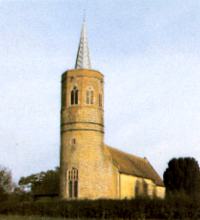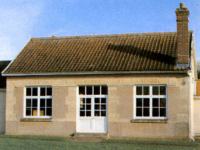Early History
The Domesday Book (1086) records Simplingaham (Scympling, an Anglo-Saxon family name, + ham – place) held as a manor by Robert of Vaux and Borstuna (Bors, an Anglo-Saxon name, + tun – farm or house). Robert Malet, Lord of the Honour of Eye, held 20 acres “in the Queen’s gift”. Later Burston became part of the manor of Brockdish. Both villages were in the Depwade Hundred. The parishes were merged in 1935. Depwade later became part of South Norfolk.
Earlier inhabitants left a Celtic stone chisel, Roman fibula and a Saxon bead of white pottery, dug up in Shimpling, and a 7th century Saxon coin in Burston. This was Iceni country. In the first century AD when the Romans invaded, the Iceni buried their treasure and, with their Queen, Boudicca, went to war – and were defeated. In the fifth century Angles and Saxons raided the East Coast, coming up the rivers in long boats to fight and plunder. Some stayed and became farmers. Later Danes came. King Edmund led the East Anglian resistance and was killed at Hoxne. In 1016 Edmund Ironside, son of King Ethelred of England, raised another army in East Anglia which was defeated. Cnut (Canute) became King of England and his son, Harold, died at the battle of Hastings (1066).
The Villages
 St. George’s Church, Shimpling, is our earliest surviving and only Grade I listed building. Construction began in the early 12th century. The round tower with four bells and part of a Norman window remain, also some 13th century coloured glass. The 14th century chancel has later additions. The first recorded Rector was Richard de Kentwell (1293). The Parish Register dates from 1538. The church was restored in 1863 and a lead-covered spire was added to the tower. In 1987 it was closed and the ecclesiastical parish merged with Dickleburgh.
St. George’s Church, Shimpling, is our earliest surviving and only Grade I listed building. Construction began in the early 12th century. The round tower with four bells and part of a Norman window remain, also some 13th century coloured glass. The 14th century chancel has later additions. The first recorded Rector was Richard de Kentwell (1293). The Parish Register dates from 1538. The church was restored in 1863 and a lead-covered spire was added to the tower. In 1987 it was closed and the ecclesiastical parish merged with Dickleburgh.
A Rector of Burston is recorded in the late 13th century. The nave of St. Mary the Virgin church was begun in 14th century with additions over the next hundred years. The chancel is 19th century. In 1753 the tower fell down and as the villagers were too poor to rebuild it the four bells were sold to Tibenham to pay for bricks to repair the wall. A wooden turret was erected for the remaining bell, inscribed: John Darbie + made + me +1683. The thatched roof was replaced with slate in 1853. In 1995 the newly formed Friends of Burston Church renovated the church so that it could be used for community activities.
During the Reformation (16th Century), St. Mary’s lost its rood screen and figures on the font were defaced. St. George’s lost memorial brasses and stained glass. Norfolk was strongly Puritan; under Queen Elizabeth I, more Catholics were burnt at the stake in our diocese than anywhere except London and Canterbury. In 1643, the Rector of Dickleburgh refused to “preserve the Reformed Religion”. Soldiers took him from Diss along the turnpike road to imprison him in Norwich castle, parishioners raced through Burston and Shimpling, rescuing him outside the Ram Inn. They hid him and his family until the Restoration of Charles II. Rev. Hugh More of Burston was more compliant.
 The Methodist chapel in Burston, built in 1825 of clay lump, was enclosed in brick in 1880. Since 1950 it has been maintained by the Fellowship for Evangelising Britain’s Villages.
The Methodist chapel in Burston, built in 1825 of clay lump, was enclosed in brick in 1880. Since 1950 it has been maintained by the Fellowship for Evangelising Britain’s Villages.
Many moats were dug in the 14th century, the clay used for clay lump houses and local brickmaking. In the 15th and 16th centuries farmhouses were built including Bridge Valley Farm, Low Farmhouse, Manor House, Valley Farmhouse, Culpher Farm, Crown Farm and High House. The Burston Crown opened in 1580. Shimpling Place, built for the Shardlowe family, was later sold to Isaac Pennington, Alderman of the City of London and one of the judges who condemned King Charles I to death in 1649. At the Restoration, Charles II confiscated it, giving it to the Duke of Grafton. Sir Edward Mann bought it and his descendants lived there for many years.
The second half of the 20th century brought another building boom, including houses built by South Norfolk Council in 1951 on the Burston to Shimpling road and Rectory Road. Electricity was installed in 1952 and piped water replaced wells and pumps – an example is the one opposite the entrance to the Crown.
Burston Railway Station, by the level crossing, opened in 1849 and for 5 months was the terminus for London trains until the line to Norwich was completed, part of an extensive network all over Norfolk. Much of this, with all the stations between Diss and Norwich including Burston, closed in 1967 after the Beeching Report.
The Public Elementary or Board School, with the master’s house beside it, was built for £850 in 1875 replacing a small school near St. Mary’s Church. It was enlarged in 1895 to accommodate 90 pupils. A new classroom was added in 2003.
 The Strike School was built in 1917 with funds from the Trades Unions and other Socialist sympathisers (names on the facade). It closed in 1939 and was a furniture store before becoming a museum and community centre.
The Strike School was built in 1917 with funds from the Trades Unions and other Socialist sympathisers (names on the facade). It closed in 1939 and was a furniture store before becoming a museum and community centre.
 Burston windmill, built in the 1850s, was bought by Mr. William Tuck in 1922 who with one employee and a cart, founded Tuck’s of Burston eventually employing 120 to produce animal feedstuffs which were exported worldwide. The mill, with granaries and the Tuck’s house, burnt down in 1931 and again in 1946. It was replaced by the current mill which has been expanded over the years by various businesses (Pauls Agriculture and BOCM) and is now branded as ForFarmers.
Burston windmill, built in the 1850s, was bought by Mr. William Tuck in 1922 who with one employee and a cart, founded Tuck’s of Burston eventually employing 120 to produce animal feedstuffs which were exported worldwide. The mill, with granaries and the Tuck’s house, burnt down in 1931 and again in 1946. It was replaced by the current mill which has been expanded over the years by various businesses (Pauls Agriculture and BOCM) and is now branded as ForFarmers.
Burston Church Green is all that remains of the last 36 acres of common land enclosed in the late 19th century. It has seen many celebrations including parties for the Queen’s wedding, coronation and golden jubilee, the raising of the village sign in 1981, the Millennium and, since 1982, the annual Strike Rally. The playing field was given to the village by Sir John Mann.
From the 1960s, many village shops closed. Burston lost its shop and post office, accommodated in various houses at different times. The wheelwright and carpenter on the corner of Higdon Close (where the Higdons had a temporary schoolroom) closed. In Shimpling, the Eagle and Child public house shut (now Eagle House); so did the blacksmiths’ forge, bakery and slaughterhouse.
The Villagers
Most were tenant farmers or farmworkers. Hemp, grown until 100 years ago, was used for nets, ropes, smocks, shrouds and payment of church tithes. Henry VIII ordered “one rood” of hemp to be grown on every farm over 60 acres for “provision of nettes for furtherance of fishing” and “eschewing idleness”.
Wool was important in the 17th century. On her travels, Celia Fiennes crossed the Waveney and saw folk “knitting, 4 or 5 in company under the hedges” and “the country is full of knitters and spinners”. In 1678 King Charles II ordered “no corpse .. . shall be buried., but in sheep’s wool only” on pain of a £5 fine. St Mary’s had a special register “for Buryals in the Parish of Burston . . in pursuance of an Act Intituled ‘An Act on Burying in Woollen’.” 
The 1845 census recorded Burston: 1405 acres, much owned by the manors of Brockdish & Winfarthing, & Heydon Hall with “468 souls” including a joiner, brick-layer, blacksmith, shoemaker, corn miller, the victualler of the Crowne, 11 farmers (4 owned their land) – growing wheat, barley, beans, turnips and mangold wurzels, a curate and “Wm. Spurling, Hall”. Shimpling; 670 acres “exclusive of commons” {grazing land open to villagers) and “216 souls” including a horse slaughterer, shopkeeper, blacksmith, parish clerk, beer retailer, grocer, 6 farmers growing wheat, barley, beans and peas, 2 twine spinners, 3 rope makers, a schoolmaster & school mistress.
The 1991 census records 537 persons in 186 households in the combined parishes.
Trouble and Strife
The Burston Strike (1914-1939) has been well documented. Parents and pupils of Burston Primary School marched again in 1981 through Diss when the school was threatened with closure.
Our villagers had rebelled before. In 1381 some, protesting the new Poll Tax, joined rebels threatening to burn Thetford. In 1822, farmworkers, whose jobs were threatened by newly invented wooden threshing machines, dragged a thresher from Shimpling to Burston and dumped it on the Green. Fifty men made a road block, unhitched the horses and smashed the machine with hatchets, hooks and crowbars. Soldiers took six men, followed by 200 angry protesters, to the Saracen’s Head in Diss to face the Justice. All six were jailed. In the 1830s farmers protested again, demanding a minimum weekly wage of 10 shillings (50p).
The first home guards or Train-bands were formed in 1557 when a Spanish invasion threatened. Depwade and Diss Hundreds called on “ablemen, smythes, laborers, Pioners, whelewrites and Trayn’d persons” to join, and parish constables to ensure attendance – “Hereof fayle not at your uttermost perills” The “Train-guard” were summoned again whenever invasion threatened: in 1621 -French & Spanish, early 1800s -Napoleon and, as the Homeguard, 1940 – German.
In the Civil War, 1642-1648, Norfolk was a Puritan stronghold (Oliver Cromwell was from East Anglia) but in the Depwade Hundred there were supporters of both sides.
In World War I (1914-1918) 38 village men fought, 30 came home, 8 are on the Norfolk Roll of Honour. Only one has a memorial here, in Burston Church.
World War II (1939-1945) brought airfields all over Norfolk, skies crisscrossed by planes, the “blackout”, air raids – an incendiary bomb fell on land at Hall Farm and a fighter plane machine-gunned Burston Mill making holes in the walls. American and RAF airmen came, landgirls and later Italian prisoners of war replaced farmworkers who had gone to fight. Child “evacuees” arrived from London in 1939 and a few stayed on. Food and clothing were rationed, also petrol so horses made a comeback.
The Future
The villages have always been changing and are likely to do so even more in the coming century. The challenge for us is to preserve the good and ensure that any change is for the better.

